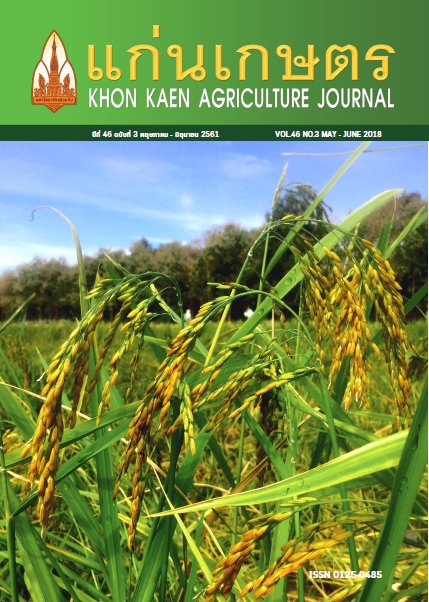ผลของการเคลือบเมล็ดพันธุ์ร่วมกับฮอร์โมนพืชผสมเพื่อยกระดับคุณภาพเมล็ดพันธุ์แตงกวาลูกผสม
Main Article Content
บทคัดย่อ
ฮอร์โมนพืชเป็นสารอินทรีย์สามารถควบคุมกระบวนการภายในเซลล์และเปลี่ยนกระบวนการทางสรีรวิทยาของเมล็ดพันธุ์ได้ การทดลองนี ้มีวัตถุประสงค์เพื่อศึกษาคุณภาพความงอกและการเจริญเติบโตของเมล็ดพันธุ์แตงกวาลูกผสมหลังการเคลือบร่วมกับฮอร์โมนพืช โดยทำการทดลอง ณ ห้องปฏิบัติการเทคโนโลยีเมล็ดพันธุ์ โรงงานปรับปรุงสภาพเมล็ดพันธุ์ คณะเกษตรศาสตร์ มหาวิทยาลัยขอนแก่น ตามกรรมวิธี ดังนี ้ 1) เมล็ดพันธุ์ที่ไม่ได้ผ่านการเคลือบ 2) เมล็ดพันธุ์เคลือบโดยไม่ใช้ฮอร์โมนพืช 3) เมล็ดพันธุ์เคลือบด้วยสารเคลือบร่วมกับ Gibberellic acid (GA3) ความเข้มข้น 4% 4) เมล็ดพันธุ์เคลือบด้วยสารเคลือบร่วมกับ Indole-3-acetic acid (IAA) ความเข้มข้น 1.5% 5) เมล็ดพันธุ์เคลือบด้วยสารเคลือบร่วมกับIndole-3-butyric acid (IBA) ความเข้มข้น 0.1% 6) เมล็ดพันธุ์เคลือบด้วยสารเคลือบร่วมกับ Alpha-naphthalene acetic acid (NAA) ความเข้มข้น 0.1% 7) เมล็ดพันธุ์เคลือบด้วยสารเคลือบร่วมกับ GA3 ความเข้มข้น 4% ผสมกับ IAA ความเข้มข้น 1.5% 8) เมล็ดพันธุ์เคลือบด้วยสารเคลือบร่วมกับ GA3 ความเข้มข้น 4% ผสมกับ IBA ความเข้มข้น 0.1% และ 9) เมล็ดพันธุ์เคลือบด้วยสารเคลือบร่วมกับ GA3 ความเข้มข้น 4% ผสมกับ NAA ความเข้มข้น 0.1% พบว่า เมล็ดพันธุ์ที่เคลือบด้วยฮอร์โมนพืชผสมทำให้เมล็ดพันธุ์มีการเจริญเติบโตมากกว่าเมล็ดพันธุ์ที่เคลือบร่วมกับฮอร์โมนพืชชนิดเดียวและมีความแตกต่างอย่างมีนัยสำคัญกับเมล็ดพันธุ์ที่ไม่ได้เคลือบในสภาพห้องปฏิบัติการ ส่วนในสภาพเรือนทดลอง พบว่า เมล็ดพันธุ์ที่เคลือบด้วยฮอร์โมนพืชผสม GA3 ความเข้มข้น 4% ผสมกับ IBA ความเข้มข้น 0.1% ทำให้เมล็ดพันธุ์มีความงอกและความเร็วในการงอกมากกว่าเมล็ดพันธุ์ที่เคลือบร่วมกับฮอร์โมนพืชชนิดเดียว ดังนั้นสรุปได้ว่า การเคลือบเมล็ดพันธุ์แตงกวาด้วยฮอร์โมนพืชผสมทำให้ความงอกและการเจริญเติบโตของต้นกล้าดีกว่าเมล็ดพันธุ์ที่เคลือบร่วมกับฮอร์โมนพืชชนิดเดียว
Article Details
เอกสารอ้างอิง
สมาคมการค้าเมล็ดพันธุ์. 2560. ปริมาณและมูลค่าการส่งออกเมล็ดพันธุ์ควบคุมประจำปี 2559. แหล่งข้อมูล https://goo.gl/SytTpo. ค้นเมื่อ 1 มีนาคม 2560.
Ahmad, A., and S. Hayat. 1999. Response of nitrate reductase to substituted IAA in pea seedlings in Srivastava. pp. 252–259. In: G.C., Singh, K., Pal, M. (Eds.), Plant physiology for sustainableagriculture, Pointer Publisher, Jaipur, India.
Ahmad, A., O.S., Hayat, Q., Fariduddin, and S. Alvi. 2001. Germination and α-amylase activity in the grains of wheat, treated with chloroindole acetic acids. Seed Technol. 23: 88-91.
Appleford, N.E.J., and J.R.Lenton. 1997. Hormonal regulation of α-amylase gene expression in germinating wheat (Triticumaestivum) grains. Physiol Plant. 100: 534–542.
Bialek I., L. Michalczuk, and J.D. Cohen. 1992. Auxin biosynthesis during seed germination in Phaseolus vulgaris. Plant Physiol. 100: 509-517.
Cleland, R.E. 1995. Auxin and cellelongation. pp.214-227. In: P.J. Davies, ed. Plant Hormones. Kluwer Academic Publishers, Dordrecht, the Netherlands.Davies, P.J. 2010. Plant hormones: Biosynthesis, Signal Transduction, Action. Springer Dordrecht Heidelberg London, New York.
Defang, Z., M. Xiang, and W. Juanjuan. 2010. Effects of an environmentally friendly seed coating agent on combating head smut of corn caused by Sphacelothe careiliana and corn growth, Journal of Agricultural Biotechnology and Sustainable Development. 2: 108-112.
Gubler, F., T. Hughes, P. Waterhouse, and J. Jacobsen. 2008. Regulation of dormancy in barley by blue light and after-ripening: effects on abscisic acid and gibberellins metabolism. Plant Physiol. 147: 886–896.
Hentrich, M., C. Boettcher, and P. Duchting. 2013. The jasmonic acid signaling pathway is linked to auxin homeostasis through the modulation of YUCCA8 and YUCCA9 gene expression. Plant J. 74: 626-637.
Hirasawa, E. 1989. Auxins induce α-amylase activity in pea cotyledons. Plant Physiol. 91: 484-486.
ISTA. 2013. International Rules for Seed testing. Seed Science and technology. Glattbrugg, Switzerland.Jennifer, S., and M. Thompson. 2004. Do rooting hormones affect the germination rate of seeds. California state science fair 2004 project summary.
Kumlay, A.M., and T. Eryigit. 2011. Growth and development regulators in plants: plant hormones.Igdır University Journal of the Institute of Science and Technology. 1: 47–56.
Liphadzi, M.S., M.B. Kirkham, and G.M. Paulsen. 2006. Auxin enhanced root growth for phytoremediation of sewage sludge amended soil. Environmental Technology. 27: 695-704.
Liu P.P., N. Koizuka, T.M. Homrichhausen, J.R. Hewitt, R.C. Martin, and H. Nonogaki. 2005. Large-scale screening of Arabidopsis enhancer-trap lines for seed germination-associated genes. Plant J. 41: 936-944.
Iglesias, R.G., and M.J. Babiano. 1997. Endogenous abscisic acid during the germination of chick-pea seed. Physiologia Plantarum. 100: 500–504.
Ivanchenko, M.G., S. Napsucialy-Mendivil, and J.G. Dubrovsky. 2010. Auxin-induced inhibition of lateral root initiation contributes to root system shaping in Arabidopsis thaliana. Plant Journal. 64: 740–752.
Maku, J., O.A.E.Gbadamosi, and S.A. Oke. 2014. Effect of some growth hormones on seed germination and seedling growth of tetrapleura tetraptera (Thaub). International Journal of Plant Research. 4: 36-42.
Magidin, M., J.K. Pittman, K.D. Hirschi, and B. Bartel. 2003. ILR2: a novel gene regulating IAA conjugate sensitivity and metal transport in Arabidopsis thaliana. The Plant Journal. 35: 523-534.
Martinez J.L., D. Petranovic, and J. Nielsen. 2016. Heme metabolism in stress regulation and protein production: From Cinderella to a key player. Bioengineered. 7: 112-115.
Mehrabi, H.R. and M.R. Chaichi. 2011. Effect of seed coating methods on germination speed of Onobrychis sativa at different drought stress levels and sowing depths seed coating technologies and treatments for onion: Challenges and Progress, International Conference on Biology, Environment and Chemistry. 24: 246–249.
Mohammad, M., and D.L. Smith. 2014. Plant hormones and seed germination. Environmental and experimental botany. 99: 110-121.
Pandit, A.H., K.M. Bhat, M.S.Wani, and M.A. Mir. 2011. Effect of IBA on cuttings of MM 106 and MM 111 apple rootstocks. ActaHortculturae. 903: 431-433.
Qing, Y.W. 2006. Effects of GA3, 6-BA and 2, 4-D Applied in Cucumber Seed Film Coating (Abstract). Available: https://goo.gl/UdnoN6. Accessed May 1, 2017.
Reza, D., M.R. Hassandokht, and V. Nazeri. 2015. Effects of moist stratification, GA3 and seed age on seed germination of Rheum khorasanicum B. Baradaran& A. Jafari. Journal of Applied Research on Medicinal and Aromatic Plants. 2: 168-173.
Scarbrough, J., and M. Thompson. 2004. Do rooting hormones affect the germination rate of seed.California state science fair 2004 project summary.
Seo, M., E. Nambara, G. Choi, and S. Yamaguchi. 2009. Interaction of light and hormone signals in germinating seeds. Plant Mol. Biol. 69: 463–472.
Sevik, H., and K. Guney. 2013. Effects of IAA, IBA, NAA, and GA3 on Rooting and Morphological Features of Melissa officinalis L. Stem Cuttings. The Scientific World Journal Volume; Article ID 909507.
Thornalley, P.J. 1990. The glyoxalase system: new developments towards functional characterization of a metabolic pathway fundamental to biological life Biochem. J. 269: 1–11.
Tremblay, F.M., and M. Lalonde. 1984. Requirements for in vitro propagation of seven nitrogen-fixing Alnus species. Plant Cell, Tissue and Organ Culture. 3: 189-199.
Turkyilmaz, B. 2012. Effects of salicylic and gibberellic acids on wheat (Triticum aestivum I.) under salinity stress. Bangladesh J. Bot. 41: 29-34.
Vanneste, S., and J. Friml. 2009. Auxin: a trigger for change in plant development. Cell. 136: 1005–1016.Woodward, A.W., and B. Bartel. 2005. Auxin: regulation, action, and interaction. Ann Bot. 95: 707–735.
Yamaguchi, S. 2008. Gibberellin metabolism and its regulation. Annu Rev Plant Biol. 59: 225–251.Zhao, Y. 2010. Auxin biosynthesis and its role in plant development. Annu Rev. Plant Biol. 61: 49–64.


